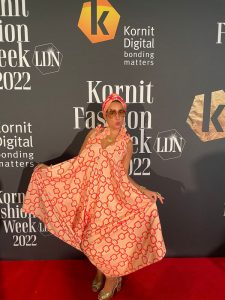It’s become a common trope that celebrities attending award shows will wear a ribbon or pin to signify their devotion to a cause that’s near and dear to them — cancer research, peaceful conflict resolution, human rights movements, and so on. When the world is watching, many take the opportunity to show solidarity.
But what if their attire itself reflects a commitment to a worthwhile cause? That is the mindset driving organizations like RCGD Global and its Red Carpet Green Dress™ initiative, which promotes eco-consciousness in global fashion design and production. With the support of celebrities taking to the “red carpet” each awards season, the initiative partners with the Academy of Motion Picture Arts and Sciences to spotlight the cause of making fashion more sustainable.
Celebrities may have the platform to model sustainably-made apparel for the world, but making sustainable apparel accessible — or the norm, the expectation — for consumers worldwide is the true objective, and one that may be closer than many even within the fashion industry may realize.
Reconciling the fashion world with demands for sustainable practices is an ongoing challenge, and one that presents no easy answers. The World Economic Forum estimates fashion and textiles are responsible for one-tenth of the world’s carbon emissions, with more than 85 percent of all textiles produced headed to the dumpster annually. The Harvard Business Review suggests there have been no significant gains for sustainable fashion since 2000, pointing to the increased overproduction of footwear as but one example. It’s well-established that textiles are one of the highest-polluting, most wasteful industries in the world, and measures such as the New York Fabric Act and European Union Strategy for Sustainable and Circular Textiles reflect the continued struggle to proactively drive the industry towards a more responsible, accountable state.
With a growing partner ecosystem spanning the technology and designer communities worldwide, companies like Kornit are committed to changing the equation for what fashion can be, its place in a more demanding and responsible marketplace, and the possibilities it presents for both unleashed expression and profitable business models. We do this by breaking the traditional production models, eliminating dependence on complex and vulnerable global supply chains, and streamlining the journey from creative concept to wearable garment.
 Consider what the traditional fashion production model entails. A concept may take more than a year to reach the runway, and to bring a garment to the marketplace requires building inventory. Building that inventory requires stable or cost-controlled access to the necessary raw materials — supply chains subject to bottlenecks, tariffs, human or labor rights concerns, pandemics, acts of God, you name it. You hope to break even by selling enough merchandise to justify that inventory. When the fashion cycle turns, you’re marking down that inventory, with unsold goods ultimately being written off, donated, scrapped, or even burned. Essentially, you’ve gambled on the popularity of your creation, and losing means not only dwindling profit margins, but in many cases a reputation for being a wasteful contributor to the problem. Ask Shein, H&M, or Burberry what that means. Overproduction isn’t sustainable as an environmental model, a business model, or a public relations model.
Consider what the traditional fashion production model entails. A concept may take more than a year to reach the runway, and to bring a garment to the marketplace requires building inventory. Building that inventory requires stable or cost-controlled access to the necessary raw materials — supply chains subject to bottlenecks, tariffs, human or labor rights concerns, pandemics, acts of God, you name it. You hope to break even by selling enough merchandise to justify that inventory. When the fashion cycle turns, you’re marking down that inventory, with unsold goods ultimately being written off, donated, scrapped, or even burned. Essentially, you’ve gambled on the popularity of your creation, and losing means not only dwindling profit margins, but in many cases a reputation for being a wasteful contributor to the problem. Ask Shein, H&M, or Burberry what that means. Overproduction isn’t sustainable as an environmental model, a business model, or a public relations model.
Digital on-demand production technology is already solving this problem for creators, brands, and fulfillers throughout the world, and that new reality is about to burst into the mainstream. E-commerce has long created a nearly unlimited array of options for the consumer, but a maturing ecosystem of digital technologies is doing the same for designers looking to fulfill their visions without compromise, brands looking to capture and capitalize on social trends the moment they’re perceptible, producers looking to create new products and tap new markets at will, and more. Virtual reality, augmented reality, and the Metaverse are giving designers and consumers alike new ways to engage each other, model concepts in real time, and “try on” any apparel virtually before committing to any one piece. And thanks to digital, only then would you actually produce the garments.
In addition to using pigment-based inks that meet several rigorous environmental standards — such as GOTS, OEKO-TEX Eco Passport and bluesign — on-demand print systems empower designers to bring their creations from concept to runway in mere weeks, with custom fabrics ready to use in minutes — perfect for sampling different materials and graphic effects. Production costs are low and consistent, so fulfilling orders of one or 1,000 yield reliable profit margins. The speed to market, supplemented by efficient workflow and visibility systems to ensure a streamlined, accountable pixel-to-parcel fulfillment process, means producing only what has been sold is a realistic business model, safeguarding operations against unforeseen disruptions, and enabling nearshoring or onshoring of operations to mitigate supply chain risks. For designers and brands, a growing network of digital-enabled fulfillers stands ready to welcome their business, supplying high-quality fulfillment of their concepts in most any materials, ready to wear or ship almost instantly.
It’s one thing to discuss the mechanics of digital fashion production, but another to see just what the finished product can be. That’s why working alongside such organizations like Red Carpet Green Dress™ is key to highlighting what bold and beautiful creations may come of a process that delivers on the promise of a digital world—using less labor, less material, less energy, less time, and less space to shrink carbon footprints while demanding no compromises, and in many cases even introducing new graphic and tactile possibilities. Our work with threeASFOUR and YesAnd at New York Fashion Week is proof this can happen. Our runway presentations at Kornit Fashion Weeks Los Angeles, Tel Aviv, and London are a testament to these possibilities.
Sustainably-made digital creations will be on the carpet at the Oscars. In the end, the award just might go to sustainable fashion on demand.
Editor’s Note: Don Whaley, Vice President of North America at Kornit Digital
April 11, 2023





